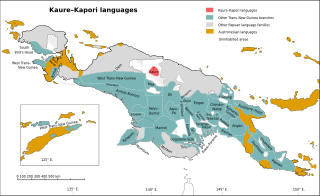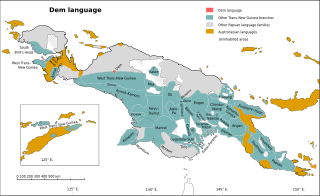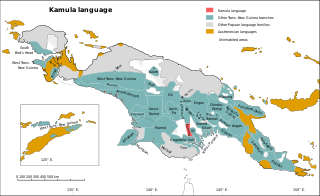Related Research Articles

The Papuan languages are the non-Austronesian and non-Australian languages spoken on the western Pacific island of New Guinea in Indonesia and Papua New Guinea, as well as neighbouring islands, by around 4 million people. It is a strictly geographical grouping, and does not imply a genetic relationship. The concept of Papuan (non-Austronesian) speaking Melanesians as distinct from Austronesian-speaking Melanesians was first suggested and named by Sidney Herbert Ray in 1892.
The Sko or Skou languages are a small language family spoken by about 7000 people, mainly along the Vanimo coast of Sandaun Province in Papua New Guinea, with a few being inland from this area and at least one just across the border in the Indonesian province of Papua.
Tayap is an endangered Papuan language spoken by fewer than 50 people in Gapun village of Marienberg Rural LLG in East Sepik Province, Papua New Guinea. It is being replaced by the national language and lingua franca Tok Pisin.

The East Geelvink Bay or East Cenderawasih languages are a language family of a dozen Papuan languages along the eastern coast of Geelvink Bay in Indonesian Papua, which is also known as Sarera Bay or Cenderawasih.
The Lakes Plain languages are a family of Papuan languages, spoken in the Lakes Plain of Indonesian New Guinea. They are notable for being heavily tonal and for their lack of nasal consonants.
Tause, also known as Doa or Darha, is a poorly-known Papuan language of Indonesia spoken by approximately 500 people, mainly in Derapos village.
Waris or Walsa is a Papuan language of northern New Guinea.
Tidore is a language of North Maluku, Indonesia, spoken by the Tidore people. The language is centered on the island of Tidore, but it is also spoken in some areas of the neighbouring Halmahera. A North Halmahera language, it is unlike most languages in Indonesia which belong to the Austronesian language family. Tidore and other North Halmahera languages are perhaps related to languages of the Bird's Head Peninsula, West Papua.
The Pauwasi languages are a likely family of Papuan languages, mostly in Indonesia. The subfamilies are at best only distantly related. The best described Pauwasi language is Karkar, across the border in Papua New Guinea. They are spoken around the headwaters of the Pauwasi River in the Indonesian-PNG border region.

The Kaure–Kosare or Nawa River languages are a small family spoken along the Nawa River in West Papua, near the northern border with Papua New Guinea. The languages are Kaure and Kosare.

The Bosavi or Papuan Plateau languages are a family of the Trans–New Guinea languages in the classifications of Malcolm Ross and Timothy Usher. The family is named after Mount Bosavi and the Papuan Plateau.
The Demta–Sentani languages form a language family of coastal Indonesian Papua near the Papua New Guinea border.

The Yam languages, also known as the Morehead River languages, are a family of Papuan languages. They include many of the languages south and west of the Fly River in Papua New Guinea and Indonesian West Papua.
The Grass languages are a group of languages in the Ramu language family. It is accepted by Foley (2018), but not by Glottolog. They are spoken in East Sepik Province, Papua New Guinea, with a small number of speakers also located just across the provincial border in Madang Province.
Kaki Ae, or Tate, is a language with about 500 speakers, half the ethnic population, near Kerema, in Papua New Guinea. It was previously known by the foreign designation Raeta Tati.
West Bird's Head languages are a small family of poorly documented Papuan languages spoken on the Bird's Head Peninsula of New Guinea.

Dem is a divergent Papuan language of West New Guinea. Although Palmer (2018) leaves it unclassified, it was tentatively included in the Trans–New Guinea family in the classification of Malcolm Ross (2005), and Timothy Usher ties it most closely to Amung.

Kamula is a Trans–New Guinea language that is unclassified within that family in the classification of Malcolm Ross (2005). Noting insufficient evidence, Pawley and Hammarström (2018) leave it as unclassified.
Molof is a poorly documented Papuan language spoken by about 200 people in Molof village, Senggi District, Keerom Regency.
Karami is an extinct and unclassified Papuan language of southern Papua New Guinea. It is attested from only a short word list, which include many loans from Foia Foia.
References
- ↑ Banaro at Ethnologue (25th ed., 2022)

- ↑ Donald C. Laycock, 1973. 'Sepik languages: checklist and preliminary classification'. Pacific linguistics, Series B, Issue 25. Australian National University, Department of Linguistics.
- ↑ Andrew Pawley, 2005, Papuan pasts